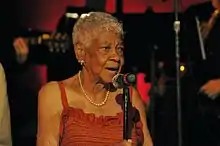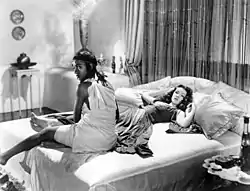Jeni Le Gon
Jeni LeGon (born Jennie Ligon, August 14, 1916 – December 7, 2012), also credited as Jeni Le Gon, was an American dancer, dance instructor, and actress. She was one of the first African-American women to establish a solo career in tap dance.
Jeni Le Gon | |
|---|---|
 in 2009 at Masters of Lindy Hop and Tap, Century Ballroom, Seattle, Washington | |
| Born | Jennie Ligon August 16, 1916 |
| Died | December 7, 2012 (aged 96) Vancouver, British Columbia, Canada |
| Occupation | Dancer, actor |
| Spouse(s) | Phil Moore |

Early years
Born as Jennie Ligon in Chicago, Illinois, her parents were Hector Ligon,[1] a chef who also worked as a railway porter, and Harriet Bell Ligon, a housewife. She grew up in the Black Belt area of Chicago and finished Sexton Elementary School in 1928.[1] When she was 13, she successfully auditioned for the chorus line of band leader Count Basie. She attended Englewood High School for one year thereafter.[1]
Career
In 1931, LeGon began performing across the southern United States with the Whitman Sisters company. In 1933, she and her half-sister, Willa Mae Lane, formed the LeGon and Lane song-and-dance team.[1]
They were given the opportunity to go to Detroit and work with nightclub owner Leonard Reed. While there, they received an offer to travel to Hollywood and perform with composer Shelton Brooks. Upon arrival, they discovered there was, in fact, no job. LeGon heard about auditions being held by Ethel Waters' former manager, Earl Dancer. The audition was for a film that Fox Studios was producing. She won the part and subsequently appeared in dance numbers in several musicals.
In 1935, she signed with RKO Pictures to be the dancing partner of Bill Robinson in the film Hooray for Love. She also performed in a 1935 London production of the revue At Home Abroad, taking over numbers that Waters and Eleanor Powell had in the Broadway version.[2]
While in Hollywood, LeGon had the opportunity to work with performers such as Waters and Al Jolson. She danced with Fred Astaire and Bill "Bojangles" Robinson, becoming the first African-American woman to do so on film. MGM signed her to a long-term contract, making LeGon the first African-American woman to receive such an opportunity, but cancellation of the contract soon followed.[1]
On Broadway, LeGon portrayed Jenny in Black Rhythm (1936), and Lily Ann in Early to Bed (1943).[3] She danced at a number of clubs and theaters including the Apollo, Cafe de Paris, Howard, Paramount and Lincoln Theaters.[4] In the early 1950s, she appeared on the televised version of Amos 'n' Andy,[2]
LeGon owned and operated the Jeni LeGon Dance Studio in Los Angeles[5] and managed the Drama & Dance Playhouse in Los Angeles. In 1969, she settled in Vancouver, British Columbia, where she taught tap and pointe. In 1999, the National Film Board of Canada released a documentary film about her life, Jeni Le Gon: Living in a Great Big Way, directed by Grant Greshuk and produced by Selwyn Jacob.[6] She appeared in the film Bones (2001).[2]
Personal life
In 1943, LeGon married composer,[1] conductor and pianist Phil Moore.[7] They composed the song "The Sping", sung by Lena Horne in the film Panama Hattie.[1]
Recognition and papers
LeGon was inducted into the Black Filmmakers Hall of Fame in 1987.[8] and into the Tap Dance Hall of Fame in 2002.[9] Oklahoma City University awarded her an honorary doctorate in 2002.[5]
LeGon's papers are housed at the Smithsonian Institution.[10]
In popular culture
Zadie Smith's novel, Swing Time, features two biracial young women who discover LeGon while watching videotapes of old film musicals. When they see her perform in Ali Baba Goes to Town (1937), the character Tracey "sits perched close to the TV, studying her moves, her mouth open in surprise."[11] LeGon becomes an obsession for Tracey.[11]
Filmography
| Year | Title | Role | Notes |
|---|---|---|---|
| 1935 | Hooray for Love | Jeni LeGon - the Ballerina | |
| 1936 | Dishonour Bright | Cabaret Dancer | |
| 1937 | Ali Baba Goes to Town | Specialty | |
| 1937 | The Adventurous Blonde | Maid | Uncredited |
| 1938 | Fools for Scandal | Singer at Le Petit Harlem | |
| 1939 | Double Deal | Nita | |
| 1940 | I Can't Give You Anything But Love, Baby | Annie | |
| 1940 | While Thousands Cheer | Myra | |
| 1940 | Glamour for Sale | Maid | Uncredited |
| 1941 | Sundown | Miriami | |
| 1941 | Birth of the Blues | Black Girl in Jail | Uncredited |
| 1941 | Bahama Passage | Mary's Maid | Uncredited |
| 1942 | This Was Paris | Cabaret Dancer | Uncredited |
| 1942 | Take My Life | Helen Stanley | |
| 1942 | Arabian Nights | Dresser | |
| 1943 | My Son, the Hero | Lambie | |
| 1943 | I Walked with a Zombie | Dancer | |
| 1943 | Stormy Weather | Dancer | Uncredited |
| 1947 | Hi-De-Ho | Minnie | |
| 1948 | Easter Parade | Essie, Nadine's Maid | Uncredited |
| 1949 | I Shot Jesse James | Veronica | |
| 1952 | Somebody Loves Me | Maid in 'Rose Room' Number | Uncredited |
| 1953 | Bright Road | Martha Swife | Uncredited |
| 1987 | Home Is Where the Hart Is | Wanda Fuch | |
| 2001 | Bones | Window Granny |
References
- "Jeni LeGon". The HistoryMakers. The HistoryMakers. Archived from the original on February 28, 2020. Retrieved February 28, 2020.
- Cullen, Frank; Hackman, Florence; McNeilly, Donald (2007). Vaudeville Old & New: an Encyclopedia of Variety Performances in America. Psychology Press. p. 670. ISBN 978-0-415-93853-2. Retrieved February 28, 2020.
- "Jeni Le Gon". Internet Broadway Database. The Broadway League. Archived from the original on February 29, 2020. Retrieved February 29, 2020.
- Williams, Dawn P. (2006). Who's Who in Black Canada 2: Black Success and Black Excellence in Canada : a Contemporary Directory. Who's Who in Black Canada. pp. 228–229. ISBN 978-0-9731384-2-9. Retrieved February 28, 2020.
- "Jeni LeGon [biography]". Performing Arts Database. Library of Congress. Archived from the original on February 29, 2020. Retrieved February 29, 2020.
- "Jeni LeGon - Living in a Great Big Way". Collection. National Film Board of Canada. Retrieved 22 February 2014.
- Gavin, James (2009). Stormy Weather: The Life of Lena Horne. Simon and Schuster. p. 185. ISBN 978-1-4391-6425-9. Retrieved February 28, 2020.
Jeni LeGon.
- "Movies". The Los Angeles Times. February 24, 1987. Archived from the original on February 28, 2020. Retrieved February 28, 2020.
- "Jeni LeGon". Tap Dance Hall of Fame. American Tap Dance Foundation. Archived from the original on February 29, 2020. Retrieved February 29, 2020.
- "Guide to the Jeni LeGon Papers". Smithsonian Online Virtual Archives. Smithsonian Institution. Archived from the original on February 29, 2020. Retrieved February 29, 2020.
- Hutchinson, Pamela. "Hooray for Jeni LeGon: the Hollywood pioneer who 'danced like a boy'". Sight&Sound. British Film Institute. Archived from the original on February 29, 2020. Retrieved February 29, 2020.
External links
| Wikimedia Commons has media related to Jeni LeGon. |
- Jeni Le Gon at IMDb
- Jeni Le Gon at the Internet Broadway Database
- Hutchinson, Pamela. "Hooray for Jeni LeGon: the Hollywood pioneer who 'danced like a boy'". BFI | Sight & Sound. Sight & Sound.
- Listing from The History Makers
- Listing from Tap Dance Hall of Fame